Feasibility Study of Transferring Shared Bicycle Users with Commuting Demand to Flex-Route Transit—A Case Study of Nanjing City, China
Abstract
:1. Introduction
2. Literature Review
3. System Description
3.1. Service Characteristics of Flex-Route Transit System
3.1.1. Operating Characteristics of Flex-Route Transit
3.1.2. Passenger Type of Flex-Route Transit
3.2. Service Area and Demand
4. Mathematical Model
4.1. Model Assumptions
4.2. Symbol Description
- Z = total cost of flex-route transit system
- Z′ = total cost of shared bicycle plus traditional fixed-route transit
- F = system time cost of the flex-route transit system and the shared bicycle system
- F1, F2, F3, F4 = vehicle driving time cost, passenger in-vehicle time cost, passenger waiting time cost, and shared bicycle riding time cost of the flex-route transit system and the shared bicycle system, respectively
- λ1, λ2, λ3 = respective cost function weight coefficient of vehicle driving time, passenger in-vehicle time, and passenger waiting time
- μ1, μ2, μ3 = respective cost function weight coefficient of vehicle driving time, passenger in-vehicle time, and shared bicycle riding time
- ω1, ω2, ω3, ω4 = respective performance index weight coefficient of vehicle driving time cost, passenger in-vehicle time cost, passenger waiting time cost, and shared bicycle riding time cost
- P = number of passengers in the flex-route transit system
- ψ = number of fixed stations of traditional fixed-route transit
- v = driving speed of the vehicle
- δ = riding speed of the shared bicycle
- ξ = shared bicycle unlock/lock time
- σt = number of passengers on the bus at time t
- θ = rated passenger capacity of bus
- dij = Manhattan distance between point i and point j
- diα = Manhattan distance between point i and the nearest fixed station α
- dφ = total length of base line of traditional fixed-route transit
- tui(q) = passenger q pick-up time at point i
- toj(q) = passenger q drop-off time at point j
- tuα(q) = passenger q pick-up time at fixed station α
- toβ(q) = passenger q drop-off time at fixed station β
- rtq = reserved pick-up time of passenger q outside the checkpoints
- mtq = most evening pick-up time of passenger q outside the checkpoints
- TC = set of checkpoints, where TC = {1, 2, …, P}
- NT = set of non-fixed stations (demand points), where NT = {P + 1, P + 2, …, P + P}
- A = set of all points on the route, where A = TC ∪ NT
- φ = set of fixed stations of traditional fixed-route transit, where φ = {1, 2, …, ψ}
- xij = {0,1}, if there is a path from i to j, then xij = 1, otherwise xij = 0
- ti = scheduled departure time of vehicle at checkpoint i
- ci = arrive time of vehicle at checkpoint i
- tc = service time of vehicle at checkpoint
- T = maximum single-trip time allowed for flex-route transit
- N1, N2, N3, N4 = respective numbers of passengers in the I, II, III, and IV categories
- Q = set of passengers, where Q = N1 ∪ N2 ∪ N3 ∪ N4
- db = maximum distance that the vehicle can drive backward in x-axis direction
- xi, xj = abscissa of point i and point j, respectively
- ∆t = waiting time that passengers can tolerate
4.3. Model Construction
4.3.1. Routing Design Model of Flex-Route Transit
4.3.2. Travel Cost Model of Shared Bicycle System
4.3.3. Time Cost Comparison Model
4.4. Simulation Design
4.4.1. Simulation Design of Flex-Route Transit System
4.4.2. Simulation Design of Shared Bicycle System
5. Result Analysis
5.1. Research Area and Parameter Values
5.2. Comparison of Flex-Route Transit System and Shared Bicycle System
5.3. Sensitivity Analysis
5.3.1. Impact Analysis of Passenger Demand Densities
5.3.2. Impact Analysis of Fixed Station Spacing
5.3.3. Impact Analysis of Travel Preference
6. Conclusions
Author Contributions
Funding
Institutional Review Board Statement
Informed Consent Statement
Data Availability Statement
Conflicts of Interest
Appendix A
| Type | Origin x | Origin y | Destination x | Destination y | Reserved Time | ID |
|---|---|---|---|---|---|---|
| N1 | 0 | 0.5 | 10 | 0.5 | 0 | 1 |
| N1 | 0 | 0.5 | 5 | 0.5 | 0 | 2 |
| N1 | 0 | 0.5 | 5 | 0.5 | 0 | 3 |
| N2 | 5 | 0.5 | 9.16 | 0.9 | 20 | 4 |
| N2 | 5 | 0.5 | 6.92 | 0.3 | 20 | 5 |
| N2 | 5 | 0.5 | 9.4 | 0.92 | 20 | 6 |
| N2 | 0 | 0.5 | 4.83 | 0.5 | 0 | 7 |
| N2 | 0 | 0.5 | 8.84 | 0.2 | 0 | 8 |
| N2 | 0 | 0.5 | 5.44 | 0.31 | 0 | 9 |
| N2 | 0 | 0.5 | 7.92 | 0.84 | 0 | 10 |
| N2 | 5 | 0.5 | 7.08 | 0.64 | 20 | 11 |
| N2 | 0 | 0.5 | 6.17 | 0.68 | 0 | 12 |
| N2 | 5 | 0.5 | 6.73 | 0.36 | 20 | 13 |
| N2 | 0 | 0.5 | 7.95 | 0.49 | 0 | 14 |
| N2 | 0 | 0.5 | 7.75 | 0.76 | 0 | 15 |
| N3 | 8.17 | 0.85 | 10 | 0.5 | 33 | 16 |
| N3 | 1.92 | 0.86 | 5 | 0.5 | 9 | 17 |
| N3 | 2.85 | 0.7 | 5 | 0.5 | 13 | 18 |
| N3 | 5.46 | 0.64 | 10 | 0.5 | 21 | 19 |
| N3 | 9.27 | 0.86 | 10 | 0.5 | 40 | 20 |
| N3 | 0.89 | 0.24 | 5 | 0.5 | 2 | 21 |
| N3 | 1.99 | 0.98 | 10 | 0.5 | 10 | 22 |
| N3 | 1.75 | 0.85 | 10 | 0.5 | 8 | 23 |
| N3 | 9.62 | 0.57 | 10 | 0.5 | 41 | 24 |
| N3 | 1.77 | 0.51 | 10 | 0.5 | 8 | 25 |
| N3 | 1.65 | 0.49 | 10 | 0.5 | 5 | 26 |
| N3 | 1.99 | 0.62 | 10 | 0.5 | 9 | 27 |
| N4 | 0.26 | 0.32 | 5.33 | 0.33 | 1 | 28 |
| N4 | 1.35 | 0.91 | 6.02 | 0.36 | 6 | 29 |
| N4 | 6.41 | 0.66 | 6.75 | 0.74 | 26 | 30 |
References
- Zhou, H.; Zhang, C.; Li, H. Influencing factors on the coopetition relationship between public bus and bike sharing based on traveler’s choice. J. Chang’an Univ. 2020, 22, 48–61. [Google Scholar]
- Becker, J.; Teal, R.; Mossige, R. Metropolitan Transit Agency’s Experience Operating General-Public Demand-Responsive Transit. Transp. Res. Rec. J. Transp. Res. Board 2013, 2352, 136–145. [Google Scholar] [CrossRef]
- Fittante, S.R.; Lubin, A. Adapting the Swedish Service Route Model to Suburban Transit in the United States. Transp. Res. Rec. J. Transp. Res. Board 2016, 2563, 52–59. [Google Scholar] [CrossRef]
- Chang, S.K.; Lee, C.J. Welfare comparison of fixed-and flexible-route bus systems. Transportation Research Record. J. Trans. Res. Board. 1993, 1390, 16–22. [Google Scholar]
- Li, X.; Quadrifoglio, L. Optimal Zone Design for Feeder Transit Services. Transp. Res. Rec. J. Transp. Res. Board 2009, 2111, 100–108. [Google Scholar] [CrossRef] [Green Version]
- Kim, M.; Schonfeld, P. Conventional, Flexible, and Variable-Type Bus Services. J. Transp. Eng. 2012, 138, 263–273. [Google Scholar] [CrossRef]
- Kim, M.; Schonfeld, P. Integrating bus services with mixed fleets. Transp. Res. Part B Methodol. 2013, 55, 227–244. [Google Scholar] [CrossRef]
- Kim, M.; Schonfeld, P. Integration of conventional and flexible bus services with timed transfers. Transp. Res. Part B Methodol. 2014, 68, 76–97. [Google Scholar] [CrossRef]
- Kim, M.; Schonfeld, P. Maximizing net benefits for conventional and flexible bus services. Transp. Res. Part A Policy Pract. 2015, 80, 116–133. [Google Scholar] [CrossRef]
- Zheng, Y.; Li, W.; Qiu, F.; Wei, H. The benefits of introducing meeting points into flex-route transit services. Transp. Res. Part C Emerg. Technol. 2019, 106, 98–112. [Google Scholar] [CrossRef]
- Chandra, S.; Quadrifoglio, L. A model for estimating the optimal cycle length of demand responsive feeder transit services. Transp. Res. Part B Methodol. 2013, 51, 1–16. [Google Scholar] [CrossRef]
- Saeed, K.; Kurauchi, F. Enhancing the Service Quality of Transit Systems in Rural Areas by Flexible Transport Services. Transp. Res. Procedia 2015, 10, 514–523. [Google Scholar] [CrossRef] [Green Version]
- Fu, L. Planning and Design of Flex-Route Transit Services. Transp. Res. Rec. J. Transp. Res. Board 2002, 1791, 59–66. [Google Scholar] [CrossRef] [Green Version]
- Zhu, H.; Kennedy, T.; Ma, H.; Zhang, H.; Leil, B.; Gningue, Y. A simulation system for flexible transit services based on E-CARGO. In Proceedings of the 2018 IEEE 15th International Conference on Networking, Sensing and Control (ICNSC), Zhuhai, China, 27–29 March 2018; Institute of Electrical and Electronics Engineers (IEEE): New York, NY, USA, 2018; pp. 1–6. [Google Scholar]
- Zheng, Y.; Li, W.; Qiu, F. A slack arrival strategy to promote flex-route transit services. Trans. Res. Part C Emerg. Technol. 2018, 92, 442–455. [Google Scholar] [CrossRef]
- Babak, M.; Yongzhe, Y.; Sushreeta, M. Analytical models for comparing operational cost of regular bus and semi flexible transit services. Public Trans. 2020, 12, 147–169. [Google Scholar]
- Marković, N.; Nair, R.; Schonfeld, P.; Miller-Hooks, E.; Mohebbi, M. Optimizing dial-a-ride services in Maryland: Benefits of computerized routing and scheduling. Transp. Res. Part C Emerg. Technol. 2015, 55, 156–165. [Google Scholar] [CrossRef]
- Kirchler, D.; Calvo, R.W. A Granular Tabu Search algorithm for the DialaRide Problem. Transp. Res. Part B Methodol. 2013, 56, 120–135. [Google Scholar] [CrossRef]
- Masmoudi, M.A.; Braekers, K.; Masmoudi, M.; Dammak, A. A hybrid genetic algorithm for the heterogeneous dial-a-ride problem. Comput. Oper. Res. 2017, 81, 1–13. [Google Scholar] [CrossRef]
- Tong, L.; Zhou, L.; Liu, J.; Zhou, X. Customized bus service design for jointly optimizing passenger-to-vehicle assignment and vehicle routing. Transp. Res. Part C Emerg. Technol. 2017, 85, 451–475. [Google Scholar] [CrossRef]
- Jäppinen, S.; Toivonen, T.; Salonen, M. Modelling the potential effect of shared bicycles on public transport travel times in Greater Helsinki: An open data approach. Appl. Geogr. 2013, 43, 13–24. [Google Scholar] [CrossRef]
- Yang, X.-H.; Cheng, Z.; Chen, G.; Wang, L.; Ruan, Z.-Y.; Zheng, Y.-J. The impact of a public bicycle-sharing system on urban public transport networks. Transp. Res. Part A Policy Pract. 2018, 107, 246–256. [Google Scholar] [CrossRef]
- Martin, E.W.; Shaheen, S.A. Evaluating public transit modal shift dynamics in response to bikesharing: A tale of two U.S. cities. J. Transp. Geogr. 2014, 41, 315–324. [Google Scholar] [CrossRef] [Green Version]
- Guo, Y.; He, S.Y. Built environment effects on the integration of dockless bike-sharing and the metro. Transp. Res. Part D Transp. Environ. 2020, 83, 102335. [Google Scholar] [CrossRef]
- Kong, H.; Jin, S.T.; Sui, D.Z. Deciphering the relationship between bikesharing and public transit: Modal substitution, integration, and complementation. Transp. Res. Part D Transp. Environ. 2020, 85, 102392. [Google Scholar] [CrossRef]
- Bronsvoort, K. Exploring Alternative Public Transport in Rural Areas. Master’s Thesis, Delft University of Technology, Delft, The Netherlands, 2019. [Google Scholar]
- Bronsvoort, K.A.; Alonso-Gonz’alez, M.J.; van Oort, N.; Molin, E.J.E.; Hoogendoorn, S.P. Preferences towards Bus Alternatives in Rural Areas of the Netherlands: A Stated Choice Experiment; Transportation Research Board: Washington, DC, USA, 2020. [Google Scholar]
- Quadrifoglio, L.; Dessouky, M.M.; Palmer, K. An insertion heuristic for scheduling Mobility Allowance Shuttle Transit (MAST) services. J. Sched. 2007, 10, 25–40. [Google Scholar] [CrossRef]
- China Academy of Urban Planning & Design; Baidu Map Huiyan. 2020 National Commuting Monitoring Report in Major Cities-Commute Time Consumption Supplement (Research Report). Available online: http://huiyan.baidu.com/reports/landing?id=76 (accessed on 24 May 2021).
- Paulley, N.; Balcombe, R.; Mackett, R.; Preston, J.; White, P. The Demand for Public Transport. In Proceedings of the World Conference on Transport Research, Istanbul, Turkey, 4–8 July 2004. [Google Scholar]
- Beirão, G.; Cabral, J.S. Understanding attitudes towards public transport and private car: A qualitative study. Transp. Policy 2007, 14, 478–489. [Google Scholar] [CrossRef]
- El-Assi, W.; Mahmoud, M.S.; Habib, K.N. Effects of built environment and weather on bike sharing demand: A station level analysis of commercial bike sharing in Toronto. Transportation 2017, 44, 589–613. [Google Scholar] [CrossRef]
- Hu, L.; Schneider, R.J. Shifts between Automobile, Bus, and Bicycle Commuting in an Urban Setting. J. Urban Plan. Dev. 2015, 141, 04014025. [Google Scholar] [CrossRef] [Green Version]
- Sun, Y.; Mobasheri, A.; Hu, X.; Wang, W. Investigating Impacts of Environmental Factors on the Cycling Behavior of Bicy-cle-Sharing Users. Sustainability 2017, 9, 1060. [Google Scholar] [CrossRef] [Green Version]
- Ye, R.; Titheridge, H. Satisfaction with the commute: The role of travel mode choice, built environment and attitudes. Transp. Res. Part D Transp. Environ. 2017, 52, 535–547. [Google Scholar] [CrossRef]

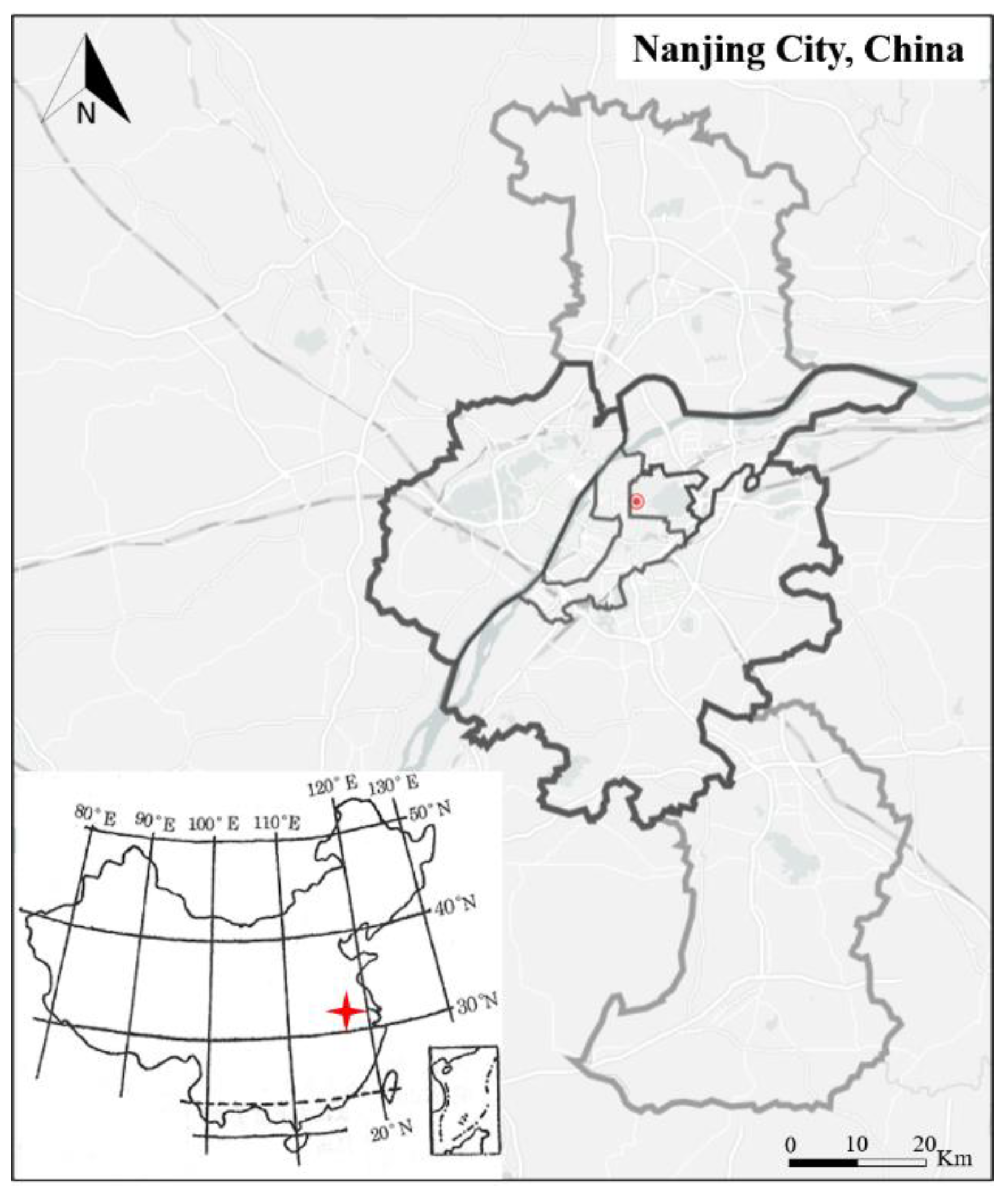
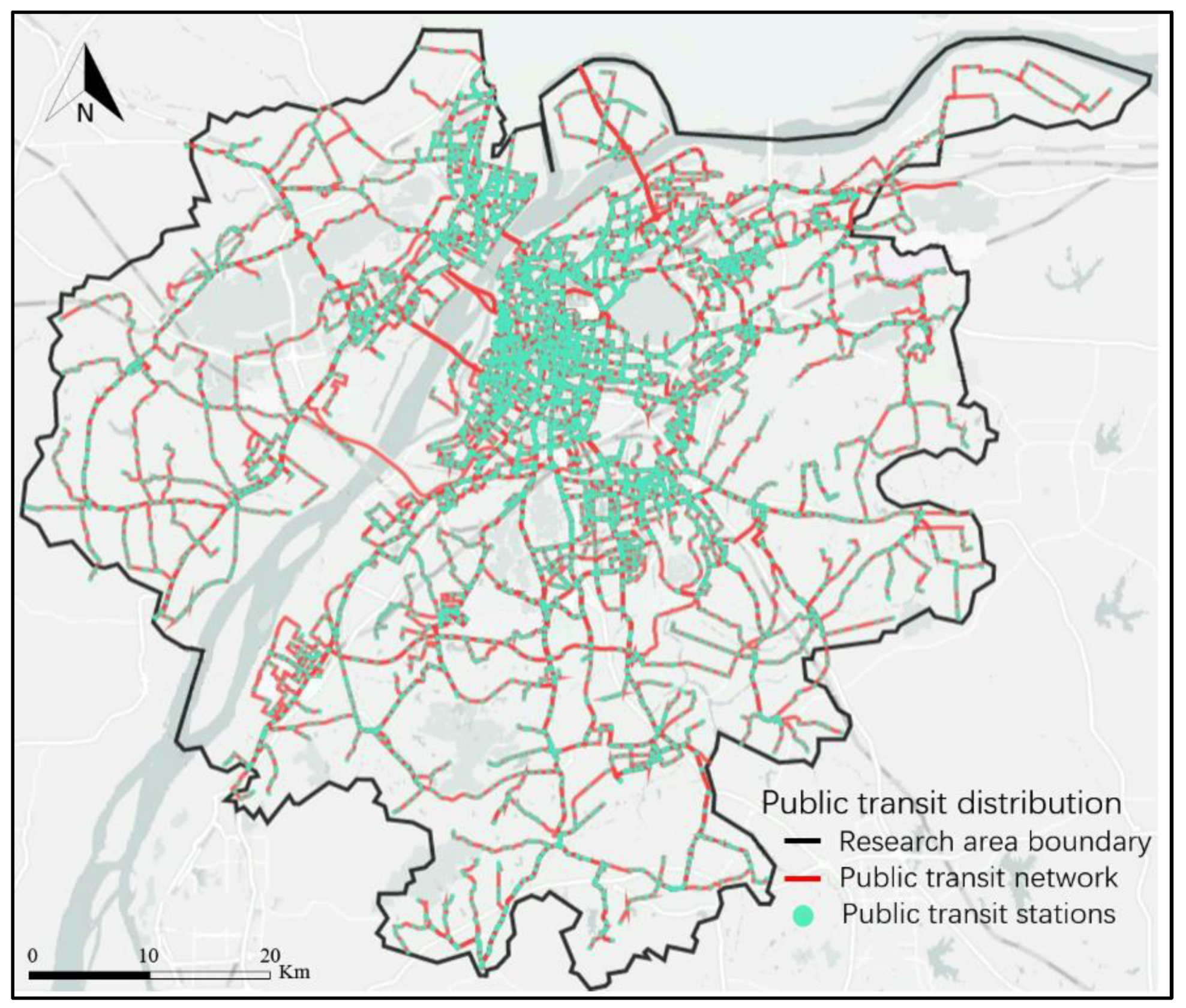
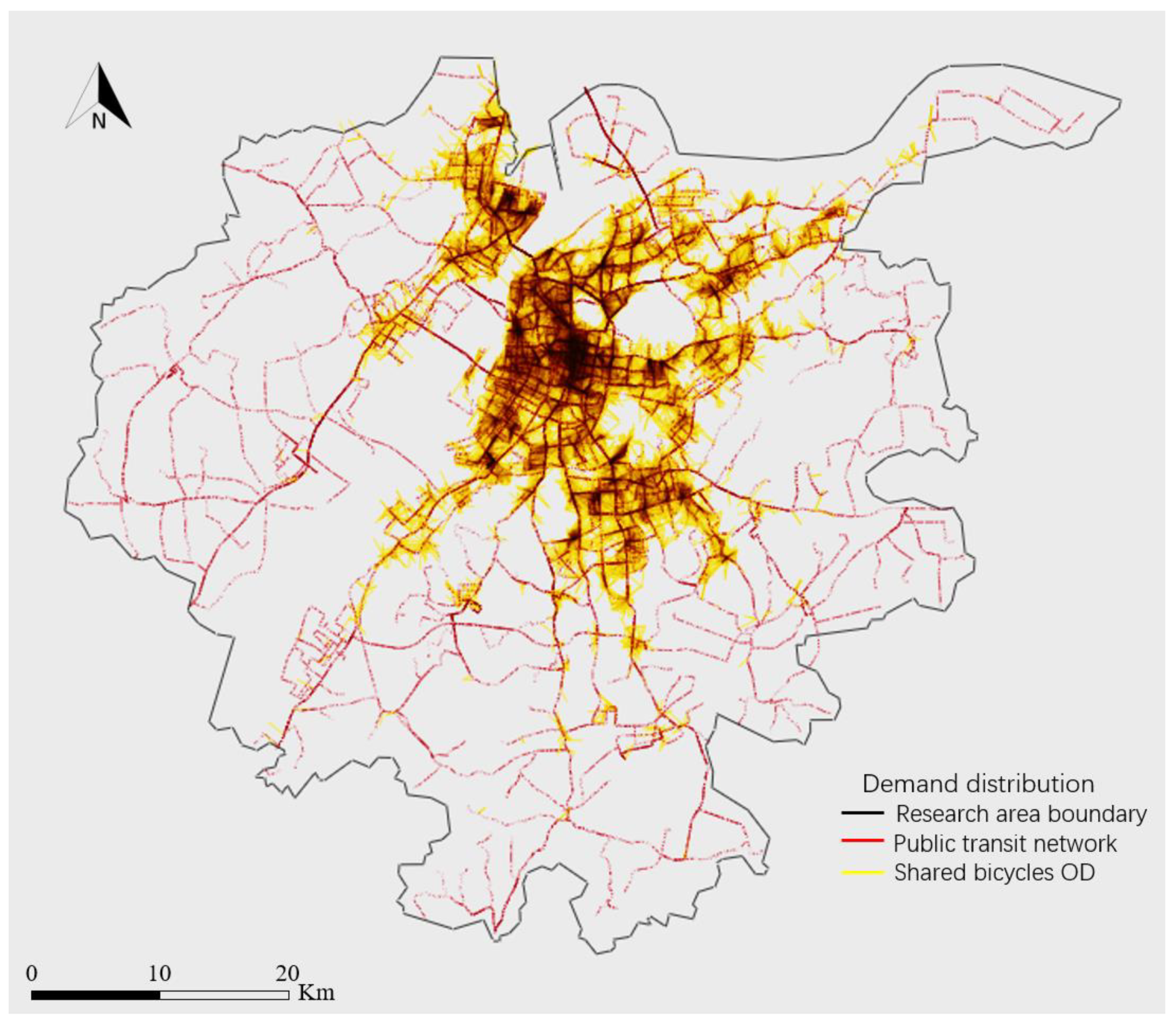

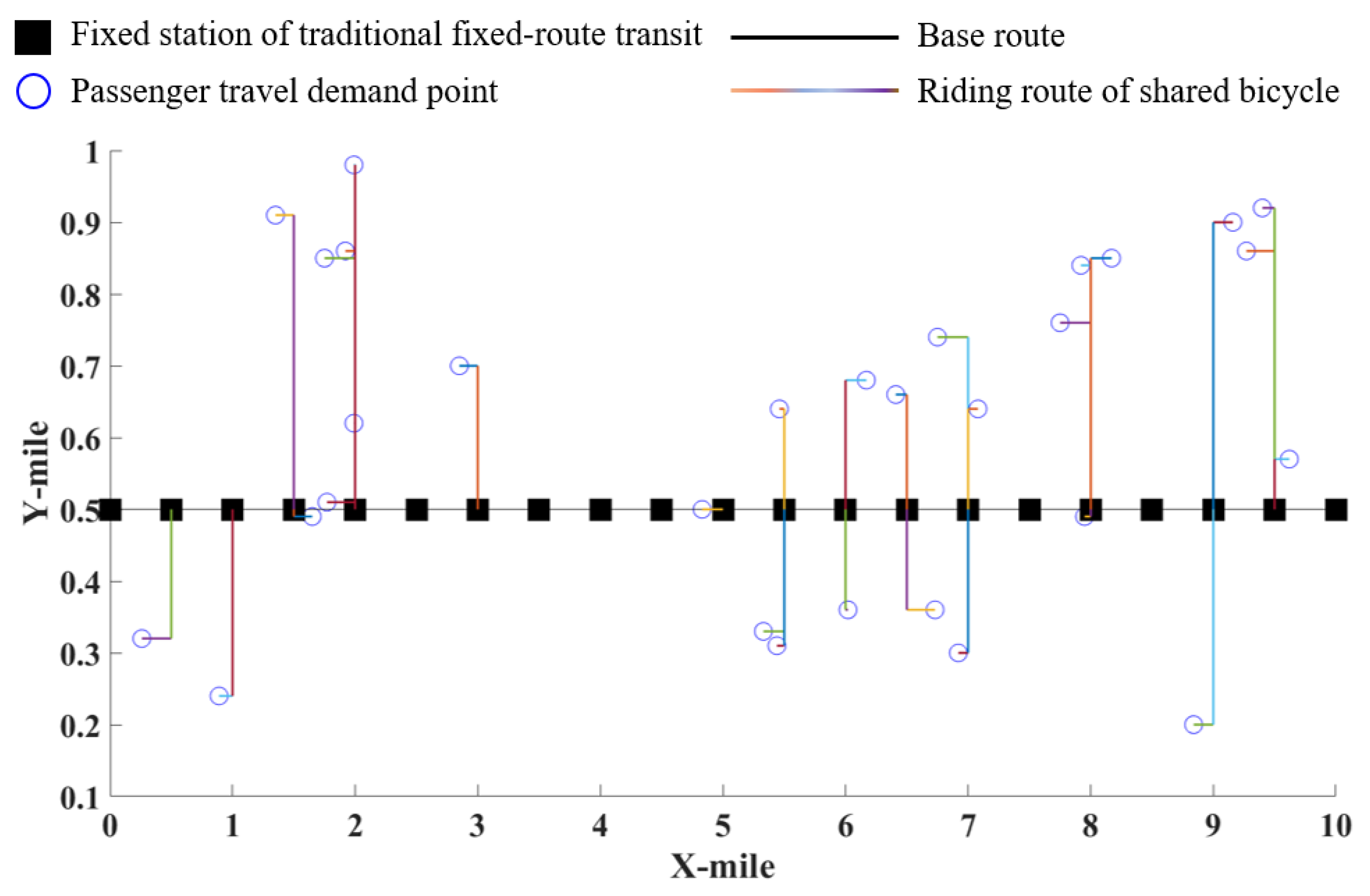
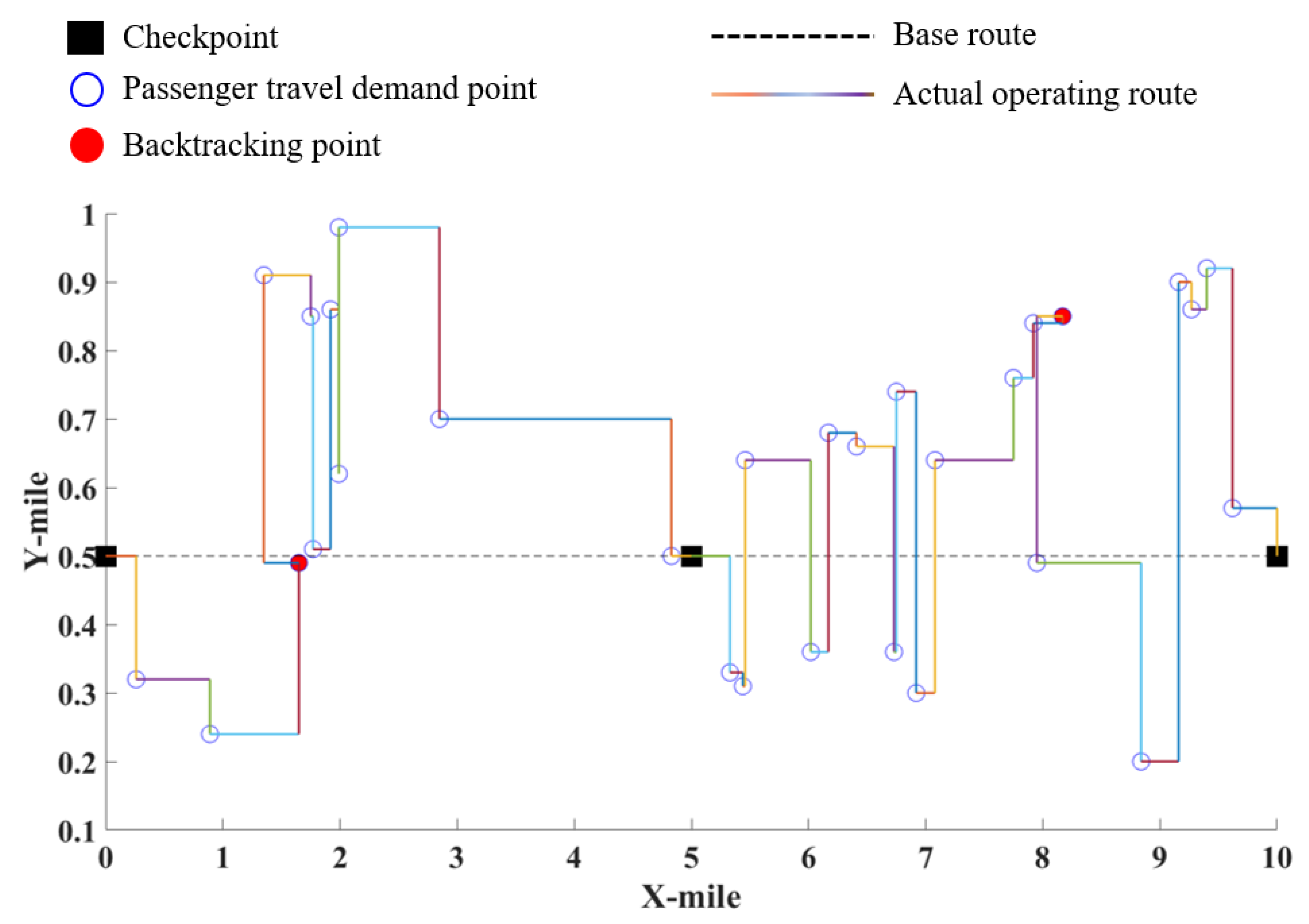
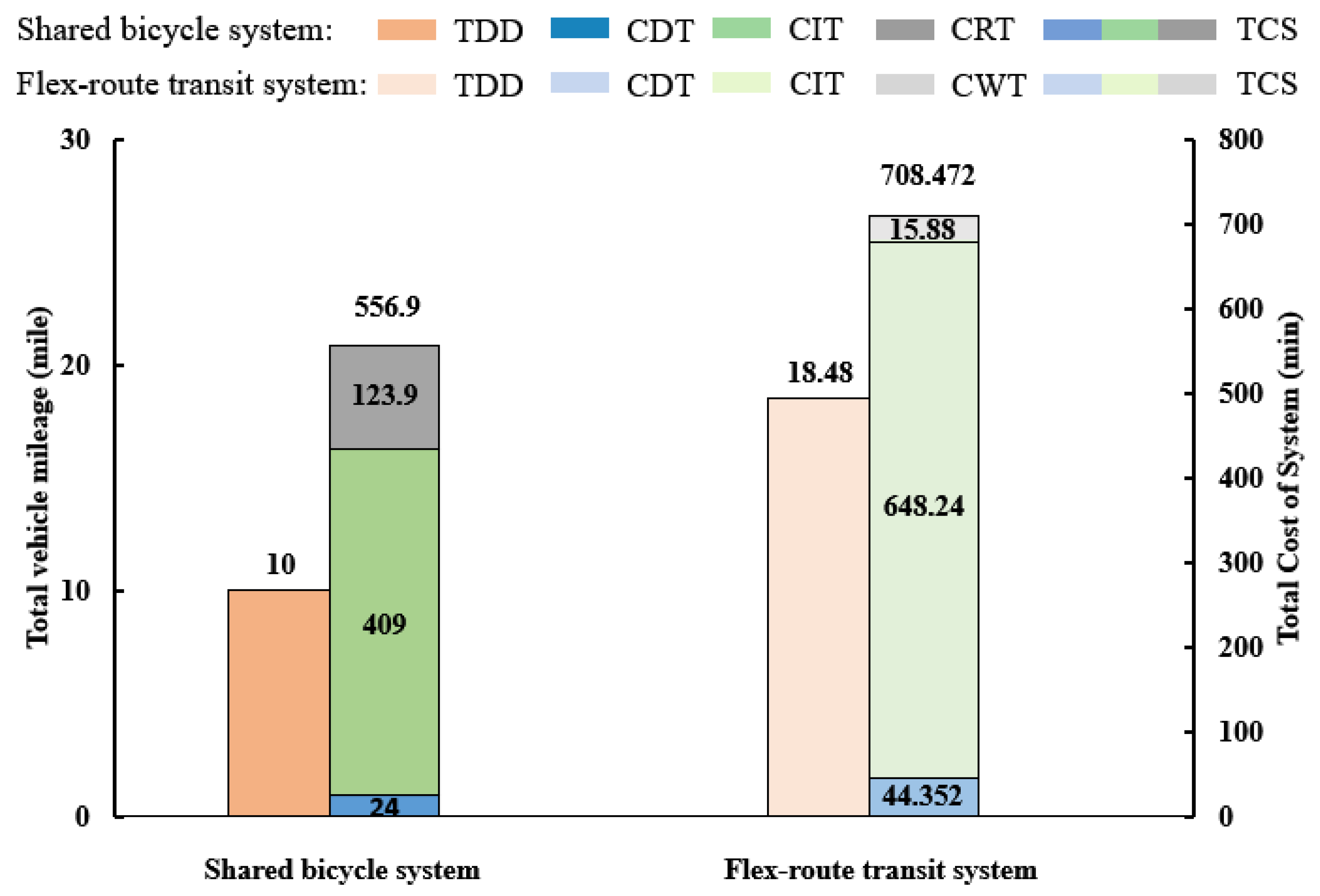
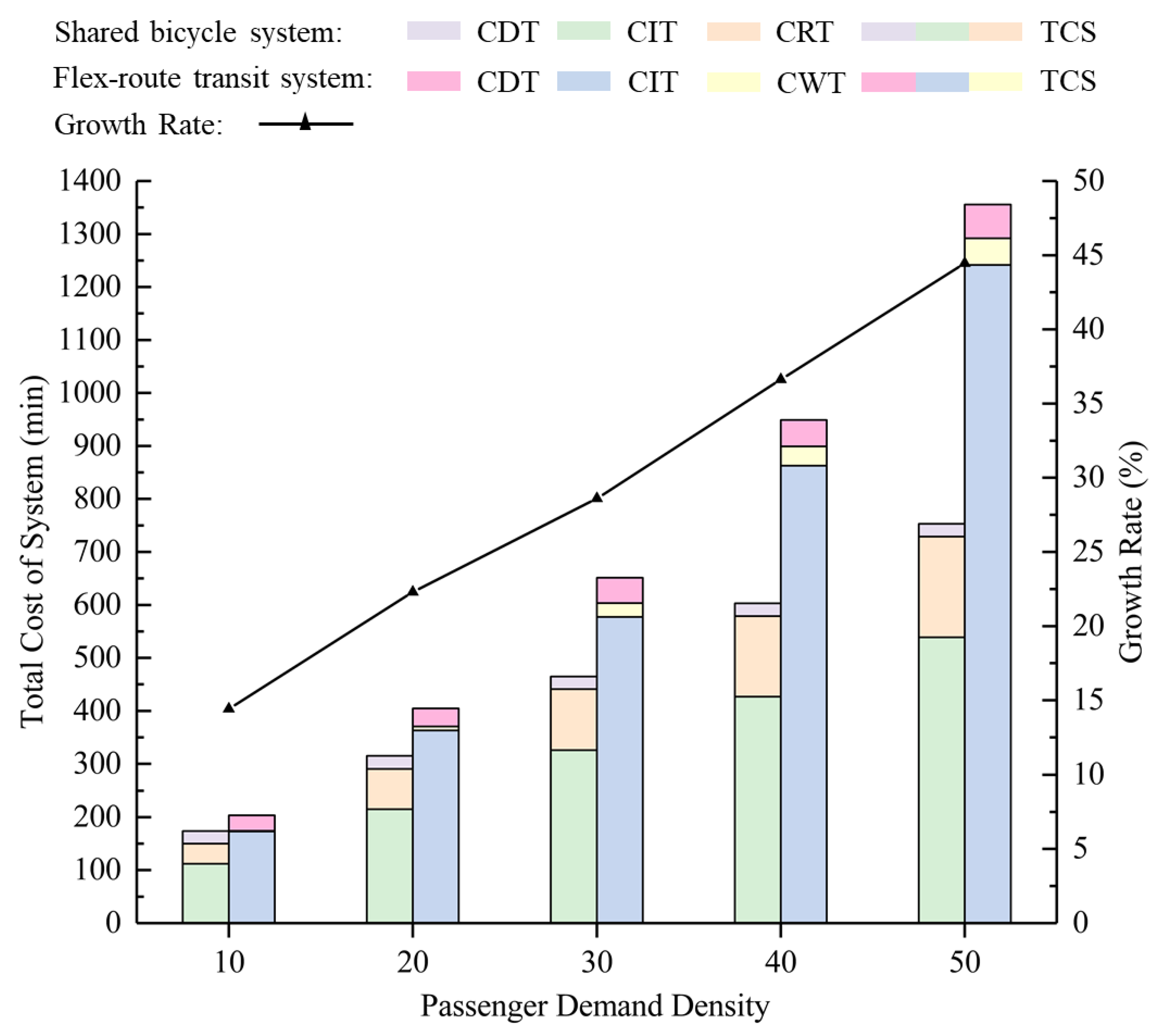
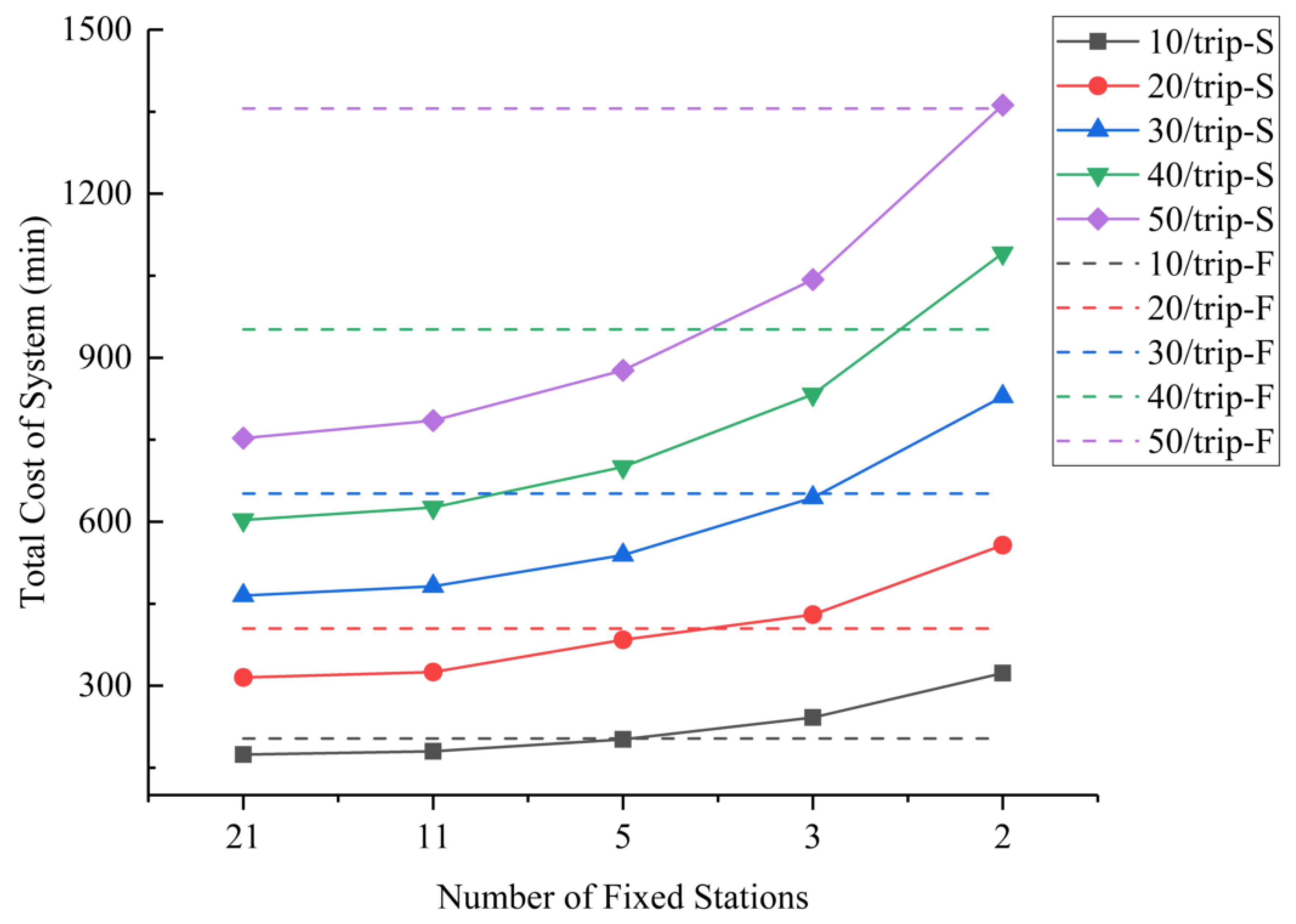

| Parameters | Values | Unit |
|---|---|---|
| T | 60 | min |
| ∆t | 5 | min |
| v | 25 | mile/h |
| δ | 10 | mile/h |
| ξ | 1 | min |
| tc | 1 | min |
| db | 0.3 | mile |
| θ | 50 | |
| PN1 | 10 | % |
| PN2 | 40 | % |
| PN3 | 40 | % |
| PN4 | 10 | % |
| λ1/λ2/λ3 | 1/1/1 | |
| μ1/μ2/μ3 | 1/1/1 | |
| ω1/ω2/ω3/ω4 | 1/1/1/1 |
Publisher’s Note: MDPI stays neutral with regard to jurisdictional claims in published maps and institutional affiliations. |
© 2021 by the authors. Licensee MDPI, Basel, Switzerland. This article is an open access article distributed under the terms and conditions of the Creative Commons Attribution (CC BY) license (https://creativecommons.org/licenses/by/4.0/).
Share and Cite
Zhang, J.; Li, W.; Wang, G.; Yu, J. Feasibility Study of Transferring Shared Bicycle Users with Commuting Demand to Flex-Route Transit—A Case Study of Nanjing City, China. Sustainability 2021, 13, 6067. https://doi.org/10.3390/su13116067
Zhang J, Li W, Wang G, Yu J. Feasibility Study of Transferring Shared Bicycle Users with Commuting Demand to Flex-Route Transit—A Case Study of Nanjing City, China. Sustainability. 2021; 13(11):6067. https://doi.org/10.3390/su13116067
Chicago/Turabian StyleZhang, Jin, Wenquan Li, Guoqing Wang, and Jingcai Yu. 2021. "Feasibility Study of Transferring Shared Bicycle Users with Commuting Demand to Flex-Route Transit—A Case Study of Nanjing City, China" Sustainability 13, no. 11: 6067. https://doi.org/10.3390/su13116067






